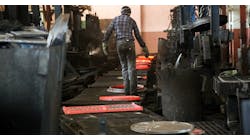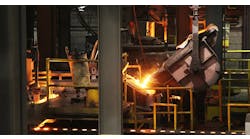Didion’s Mark 5 Series rotary media drum combines casting cleaning and cooling with sand conditioning.
Every foundry aims to produce quality castings and to achieve profitability, but the industry’s renewed emphasis on plant safety should ensure that there are now at least three priorities. In the development and design of capital equipment for foundries, safety is already a consideration. And it should be obvious that this includes shakeout systems.
When a mold is processed in a shakeout to separate a casting from the sand, the potential is great that high volumes of silica dust will be released into the working environment, or beyond. When inhaled, silica dust can cause silicosis, an incurable lung disease that is the cause of thousands of deaths annually. But that’s not the only reason to capture the sand: Airborne sand contaminates other machines, and increasing the percentage of return sand lowers raw material costs overall.
Didion International introduced its Mark 5 Series rotary media drum recently, a unit that combines shakeout with sand conditioning and screening and casting cleaning and cooling. That combination of functions keeps the plant cleaner, according to the equipment builder, and saves production costs and time.
General Kinematics’ Vibra-Drum uses “natural frequency vibratory action” to make the sand flow effectively, in rder to reduce lumbs and clean casting surfaces.
In addition, the combination reduces capital equipment costs, floor space, energy costs, maintenance time and costs, media consumption, and replacement parts. It also improves plant working conditions, and returns cleaner sand for reuse.
Didion emphasizes that the Mark 5 Series returns sand that is blended and conditioned, so it is consistent in temperature and moisture content. Importantly, the sand remains in the system; with just a small open area, dust collection is simplified, too. The machine uses counterflow air to eliminate fugitive dust from escaping into the atmosphere, and the builder says the system “requires 75% less dust collection than a vibrating shakout rated at the same capacity.
The Mark 5 is said to be the only shakeout system that separates core sand from green sand and discharges them independently. It’s a valuable function for high-throughput foundries producing high volumes of cored castings that need to manage core sand they recycling levels.
Carrier Vibrating Equipment calls its Barrel Horse rotary shakeout a “one-step solution” to casting damage and sand mixing problems. Rather than lifting and dropping the castings, as is typical for rotary systems, the Barrel Horse allows the castings to “swim” in the sand, so the vibratory motion constantly blends the sand. This transfers heat from the castings to the sand, cleans the castings effectively, and reduces sand lumps for more uniform return sand.
Carrier’s top-of-the-line shakeout is its Delta-Phase model, which uses a process controller to manage the angle of vibration. The changing angle makes it possible to control the conveying speed and retention time of castings in the shakeout, and optimizes sand removal. Foundries with a wide variety of castings and sizes can pre-program the process settings to optimize sand removal without damaging castings, and speeding throughput.
Sand can be managed with Carrier’s vibrating fluid-bed sand coolers, which use evaporative cooling for maximum thermal efficiency. Vibration fluidizes the sand, and helps to make it consistent in temperature and moisture. Controls regulate and maintain supply and exhaust air volumes at a constant, pre-set level to prevent sand escaping the system. A specially designed hood minimizes dusting and produces more uniform exhaust velocities.
General Kinematics Corp. offers shakeout machines for rotary and vibratory processes, but it emphasizes vibratory drums for foundries concerned about minimizing casting damage. Vibratory drums also are simple to outfit with dust collection and air system attachments, or other peripheral attachments.
GK’s Vibra-Drum series are high-throughput systems with a “natural frequency vibratory action” that produces effective rotation of the sand and casting bed to reduce sand lumps quickly, and cleans surface sand from castings. This motion reduces the chances of damage to castings, and the castings and sand are typically discharged onto a twomass sand separator to screen the grain size sand from the castings and to loosen any remaining core sand from the castings.
GK’s Vibra series also includes the Vibra- Claim shakeout/attrition mill, for single-unit removal and reprocessing of sand. The vibratory action separates the sand from the casting, breaks down the sand, and helps collect it for reclamation. After screening, the sand is available for reuse.









